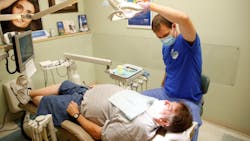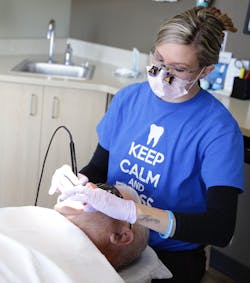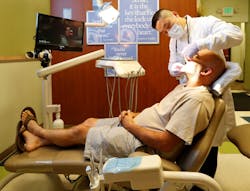Effective ways to treat patients with dental anxiety
Amanda Apple, LDH, BGS
In a recent survey of 18,000 people worldwide, 61% of respondents reported that they suffer from dental fear and anxiety.1 Often, a patient’s anxiety manifests as dental avoidance, which can lead to extreme oral health complications or a low quality of life. Within a dental office, anxious patients can present as irritable and/or uncooperative, and tend to have a greater pain response than their calm counterparts. These responses are problematic for not only the patient, but for dental professionals, since these negative feelings of anxiety can translate to dental staff and clinicians.
“Anxious patients are very upsetting to me,” says Natica Boland, a registered dental hygienist (RDH) who works an Aspen Dental office in Ankeny, Iowa. “They increase my stress and anxiety throughout the entirety of their appointment, and it can even be hard to fully calm my nerves after the appointment when I’m onto the next patient. When I coach breathing techniques with my anxious patient, I end up doing the exercises too to help my anxiety in treating the anxious patient.”
To avoid negative experiences for patients and ensure quality care, it’s critical for dentists and all team members to understand and practice effective ways to help patients with dental anxiety, as well as address and overcome their fears. This is especially true for RDHs, as they are often the first to encounter patients chairside. A dental professional’s goal should be to alleviate anxiety in such a way that patients are satisfied and properly cared for in the short term, but also positively motivated on a long-term basis for future dental visits.2
Here are several strategies to effectively manage, treat, and encourage anxious dental patients that have proven valuable in offices across the nation.
Caring and communication
For patients with dental anxiety, empathy and understanding go a long way. Taking time to listen to patients voice their fears and concerns can make them feel welcome and, ultimately, relaxed.
“The most important thing about being a good dentist is being comforting and being a good communicator,” says Natalie Semaan, the lead dentist at Aspen Dental's Bourbonnais, Illinois, office. A patient’s relationship with his/her dentist and dental team is just like any other—it benefits from open, honest communication. When speaking to patients, normalizing anxious feelings and avoiding negative phrasing is beneficial. Furthermore, patients should be encouraged to ask questions, and they should be kept informed throughout the dental procedure.2
An effective way to do this is the tell-show-do technique. The “tell” part of the technique involves verbal explanations of the overall procedure as well as associated steps along the way. The “show” includes demonstrations for the patient of the visual, auditory, olfactory, and tactile aspects of the procedure. The “do” part of the technique is the completion of the dental procedure—without deviating from the roadmap laid out in “tell” and “show.”3 Verbally checking on the patient before, during, and after the dental procedure is a great way to establish a sensitive, empathetic approach.
Control and distraction
Dentists and team members have found giving patients with dental anxiety control over their entire appointment, including the specific dental procedure, is beneficial. For example, letting the patient decide when work begins—there is a difference between “let me know when you are ready,” and “open wide.”
Boland allows anxious patients to hold the saliva suction, giving them control over when they need to expectorate. She also encourages patients to express when they need a break—simple but clear hand signals for “stop” and “continue” enable anxious patients to control the pace of the appointment.
Offering distractions is another way to allow patients to control their dental appointment. Calming, engaging music throughout the dental office helps, as does encouraging patients to bring their own headphones and playlists. Equipping each dental chair with a television is another strategy—one many tech-savvy offices have adopted.
For the less technologically inclined, asking a patient about a hobby or recent positive experience can be just as calming.
Scheduling and office environment
Scheduling and office ambiance can play a significant role in reducing dental anxiety. From the waiting room to the chair, anxious patients take in everything they see, hear, and smell. In some cases, this can worsen a patient’s mental state.
Boland says it’s important to schedule patients with dental anxiety in the morning, as afternoon appointments leave them more time to worry and only serve to increase their anxiety. That same logic is used when anxious patients arrive at Boland’s office—the team tries to seat the patients as quickly as possible to avoid the patient fretting in the waiting room for an extended period.
Regardless of wait time, a patient with dental anxiety will still be unsure as he or she enters the office. But a calm, inviting office environment can help reverse the effect of the sound of a drill or the smell of eugenol.
“In my operatory, for example, I have a diffuser with stress-relief essential oils that casts warm light, which slowly fades into different colors,” Boland says. “I also have plants and a Himalayan salt lamp that patients respond very well to.”
Additional ways to establish a calming office environment include
- avoidance of harsh, sterile lighting in favor of natural light;
- playing soft, engaging music;
- walls adorned with relaxing posters and pictures;
- waiting room tables with a plethora of reading options;
- closed doors to help mask smells and sounds; and
- offering patients food and/or beverages.
“Our office has plenty of natural sunlight, with lots of windows,” says Boland. “We also make coffee for our patients and have a water cooler for their convenience.”
Alternative approaches
Smell is the sense most tied to memory, and since a previous negative dental experience is one of the strongest predictors of dental anxiety, masking strong smells within a dental office is recommended for patients with dental anxiety.4
Introducing pleasant ambient odors via free-standing or automatic air fresheners is one solution. There are, however, alternative approaches, such as aromatherapy, wherein essential oils of aromatic plants can be used to produce positive physiological or pharmacological effects. Studies have proven inhalation of pleasant scents has an anxiolytic effect and improves mood, even in patients without dental anxiety.2
Helping patients physically relax, in addition to mentally, is another strategy for those experiencing dental anxiety. Proper breathing techniques are one of the most fundamental ways to encourage physical relaxation. In fact, when Boland is offering care to a patient with dental anxiety, one of the first things she does is coach them through breathing techniques. Diaphragmatic breathing, for example, relies on use of the diaphragm to reduce tension in the chest and provide more oxygen for the body per breath.2 Muscle relaxation can be done simultaneously by tensing a specific set of muscles during inhale and relaxing them during exhale.
Guided imagery is an approach that combines mental and physical relaxation into a mind-body exercise. Patients are taught to develop a mental image of a pleasant, tranquil experience—complete with specific, concrete details such as with sound, smell, and colors—that guides their attention to achieve relaxation, thereby reducing anxiety.2 Studies have shown guided imagery is effective in the treatment of distress, mood, and anxiety symptoms associated with chronic pain, social anxiety disorder, attention deficit/hyperactivity disorder, and cancer pain.5 It is also relatively easy to learn, teach, and use in daily dental practice.
Conclusion
Dental anxiety can be harmful to patients and the dental professionals working to care for them. In these cases, a dental team must take additional precautions to alleviate a patient’s anxiety in both the short and long term.
Easing a patient’s anxiety through straightforward communication has proven effective, as has portraying understanding and empathy through words and actions. Putting anxious patients in control of the appointment, such as allowing them to dictate start and stop times, can help relax their mental state. Physical relaxation is part of the equation as well, with breathing techniques, pleasant aromas, and calming music all playing a role.
It is important for all dental team members to practice effective ways to help patients with dental anxiety move forward—for the sake of their health. The approaches discussed in this article can do that, as shown by the Aspen Dental-branded offices that already successfully employ these methods and more.
References
- Dentavox study indicates over 60% of people globally suffer from dental fear, 4% never visited a dentist. Pharmabiz website. http://www.pharmabiz.com/NewsDetails.aspx?aid=111232&sid=2. Published September 17, 2018. Accessed April 15, 2019.
- Appukuttan DP. Strategies to manage patients with dental anxiety and dental phobia: literature review. Clin Cosmet Investig Dent. 2016;8:35–50. doi:10.2147/CCIDE.S63626
- American Academy of Pediatric Dentistry. Behavior guidance for the pediatric dental patient. https://www.aapd.org/globalassets/media/policies_guidelines/bp_behavguide.pdf. Revised 2015. Accessed April 15, 2019.
- McMaster R, Garisto GA. Practical considerations for treating the anxious dental patient. Oral Health Group Website. https://www.oralhealthgroup.com/features/practical-considerations-for-treating-the-anxious-dental-patient/. Published February 1, 2012. Accessed April 15. 2019.
- Gonzales EA, Ledesma RJ, McAllister DJ, Perry SM, Dyer CA, Maye JP. Effects of guided imagery on postoperative outcomes in patients undergoing same-day surgical procedures: a randomized, single-blind study. AANA J. 2010;78(3):181–188.


